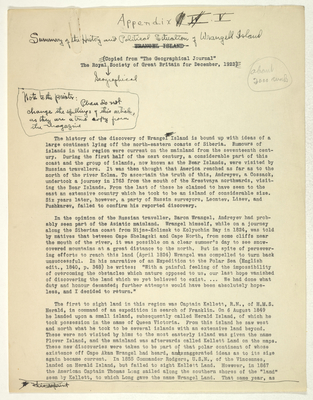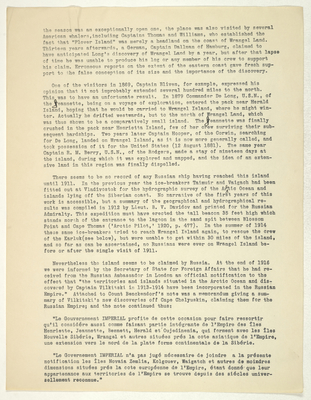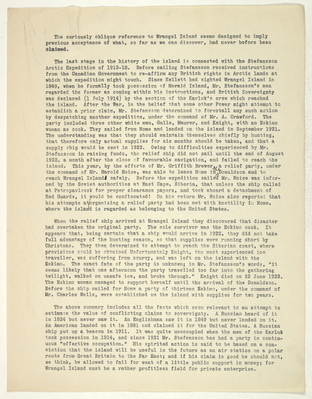Pages
stefansson-wrangel-09-30-006-001
Appendix C IV V Summary of the Hisory and Political Situation of Wrangell Island WRANGEL ISLAND- (Copied from "The Geographical Journal" The Royal Geographical Society of Great Britain for December, 1923)
The history of the discovery of Wrangel* Island is bound up with ideas of a large continent lying off the north-eastern coasts of Siberia. Rumours of islands in this region were current on the mainland from the seventeenth century. During the first half of the next century, a considerable part of this coast and the group of islands, now known as the Bear Islands, were visited by Russian travellers. It was then thought that America reached as far as to the north of the river Kolma. To ascertain the truth of this, Andreyev, a Cossack, undertook a journey in 1763 from the mouth of the Krestvaya northwards, visiting the Bear Islands. From the last of these he claimed to have seen to the east an extensive country which he took to be an island of considerable size. Six years later, however, a party of Russin surveyors, Leontev, Lisev, and Pushkarev, failed to confirm his reported discovery.
In the opinion of the Russian traveller, Baron Wrangel, Andreyev had probably seen part of the Asiatic mainland. Wrangel himself, while on a journey along the Siberian coast from Nijne-Kolimsk to Kolyuchin Bay in 1824, was told by natives that between Cape Shelagski and Cape North, from some cliffs near the mouth of the river, it was possible on a clear summer’s day to see snowcovered mountains at a great distance to the north. But in spite of persevering efforts to reach this land (April 1824) Wrangel was compelled to turn back unsuccessful. In his narrative of an Expedition to the Polar Sea (English edit., 1840, p. 348) he writes: "With a painful feeling of the impossibility of overcoming the obstacles which nature opposed to us, our last hope vanished of discovering the land which we yet believed to exist. ... We had done what duty and honour demanded; further attempts would have been absolutely hopeless, and I decided to return."
The first to sight land in this region was Captain Kellett, R.N., of H.M.S. Herald, in command of an expedition in search of Franklin. On 6 August 1849 he landed upon a small island, subsequently called Herald Island, of which he took possession in the name of Queen Victoria. From this island he saw west and north what he took to be several Islands with an extensive land beyond. These were not visited by him: to the most easterly island was given the name Plover Island, and the mainland was afterwards called Kellett Land on the maps These new discoveries were taken to be part of that polar continent of whose existence off Cape Akan Wrangel had heard, andexaggerated ideas as to its size again became current. In 1855 Commander Rodgers, U.S.N., of the Vincennes, landed on Herald Island, but failed to sight Kellett Land. However, in 1867 the American Captain Thomas Long sailed along the southern shores of the "land seen by Kellett, to which Long gave the name Wrangel Land. That same year, as
stefansson-wrangel-09-30-006-002
the season was an exceptionally open one, the place was also visited by several American whalers,including Captains Thomas and Williams, who established the fact that "Plover Island" was merely a headland on the coast of Wrangel Land. Thirteen years afterwards, a German, Captain Dallman of Hamburg, claimed to have anticipated Long's discovery of Wrangel Land by a year, but after that lapse of time he was unable to produce his log or any member of his crew to support his claim. Erroneous reports on the extent of the eastern coast gave fresh support to the false conception of its size and the importance of the discovery.
One of the visitors in 1869, Captain Bliven, for example, expressed his opinion that it not improbably extended several hundred miles to the north. This was to have an unfortunate result. In 1879 Commander De Long, U.S.N., of the Jeannette, being on a voyage of exploration, entered the pack near Herald Island, hoping that he would be carried to Wrangel Island, where he might winter. Actually he drifted westwards, but to the north of Wrangel Land, which was thus shown to be a comparatively small island. The Jeannette was finally crushed in the pack near Henrietta Island, few of her crew surviving their subsequent hardships. Two years later Captain Hooper, of the Corwin, searching for De Long, landed on Wrangel Island, as it is now more generally called, and took possession of it for the United States (12 August 1881). The same year Captain R. M. Berry, U.S.N., of the Rodgers, made a stay of nineteen days at the island, during which it was explored and mapped, and the idea of an extensive land in this region was finally dispelled.
There seems to be no record of any Russian ship having reached this island until 1911. In the previous year the ice-breakers Taimuir and Vaigach had been fitted out at Vladivostok for the hydrographic survey of the Arctic Ocean and islands lying off the Siberian coast. No narrative of the first years of this work is accessible, but a summary of the geographical and hydrographical results was compiled in 1912 by Lieut. B. V. Davidov and printed for the Russian Admiralty. This expedition must have erected the tall beacon 35 feet high which stands north of the entrance to the lagoon in the sand spit between Blossom Point and Cape Thomas ('Arctic Pilot,' 1920, p. 477). In the summer of 1914 these same ice-breakers tried to reach Wrangel Island again, to rescue the crew of the Karluk(see below), but were unable to get within 30 miles of the island, and so far as can be ascertained, no Russians were ever on Wrangel Island before or after the single visit of 1911.
Nevertheless the island seems to be claimed by Russia. At the end of 1916 we were informed by the Secretary of State for Foreign Affairs that he had received from the Russian Ambassador in London an official notification to the effect that "the territories and islands situated in the Arctic Ocean and discovered by Captain Vilkitski in 1913-1914 have been incorporated in the Russian Empire." Attached to Count Benckendorf's note was a memorandum giving a summary of Vilkitski's new discoveries off Cape Chelyuskin, claiming them for the Russian Empire; and the note continued thus:
"Le Gouvernement IMPERIAL profite de cette occasion pour faire ressortir qu’il considere aussi comme faisant partie integrants de l'Empire des iles Henriette, Jeannette, Bennett, Herald et Oujedinenia, qui forment avec les iles Nouvelle Siberia, Wrangel et autres situees pres la cote asiatique de l’Empire, une extension vers le nord de la plate forme continentale de la Siberia.
"Le Governement IMPERIAL n'a pas juge necessaire de joindre a la presents notification les iles Novaia Zemlia, Kolgouev, Waigatch et autres de moindres dimensions situees pres la cote europeenne de l'Empire, etant donne que leur appartenance aux territories de l’Empire se trouve depuis des siecles universellement reconnue."
stefansson-wrangel-09-30-006-003
The curiously oblique reference to Wrangel Island seems designed to imply previous acceptance of what, so far as we can discover, had never before been claimed.
The last stage in the history of the island is connected with the Stefansson Arctic Expedition of 1913-18. Before sailing Stefansson received instructions from the Canadian Government to re-affirm any British rights in Arctic lands at which the expedition might touch. Since Kellett had sighted Wrangel Island in 1849, when he formally took possession of Herald Island, Mr. Stefansson's men regarded the former as coming within his instructions, and British Sovereignty was declared (l July 1914) by the section of the Karluk's crew which reached the island. After the War, in the belief that some other Power might attempt to establish a prior claim, Mr. Stefansson determined to forestall any such action by despatching another expedition, under the command of Mr. A. Crawford. The party included three other white men, Galle, Maurer, and Knight, with an Eskimo woman as cook. They sailed from Nome and landed on the island in September 1921. The understanding was that they should maintain themselves chiefly by hunting, that therefore only actual supplies for six months should be taken, and that a supply ship would be sent in 1922. Owing to difficulties experienced by Mr. Stefansson in raising funds, the relief ship did not sail until the end of August 1922, a month after the close of favourable navigation, and failed to reach the island. This year, by the efforts of Mr. Griffith Brewer, a relief party, under the command of Mr. Harold Noice, was able to leave Nome in the Donaldson and to reach Wrangel Islandl safely. Before the expedition sailfml Mr. Noice was informed by the Soviet authorities at East Cape, Siberia, that unless the ship called at Petropavlovsk for proper clearance papers, and took aboard a detachment of Red Guards, it would be confiscated! On his return Mr. Noice also reported that his attempts atorganizing a relief party had been met with hostility in Nome, where the island is regarded as belonging to the United States.
When the relief ship arrived at Wrangel Island they discovered that disaster had overtaken the original party. The sole survivor was the Eskimo cook. It appears that, being certain that a ship would arrive in 1922, they did not take full advantage of the hunting season, so that supplies were running short by Christmas. They then determined to attempt to reach the Siberian coast, where provisions could be obtained Unfortunately Knight, the most experienced ice traveller, was suffering from scurvy, and was left on the island with the Eskimo. The exact fate of the party is unknown; in Mr. Stefansson's words, "it seems likely that one afternoon the party travelled too far into the gathering twilight, walked on unsafe ice, and broke through." Knight died on 22 June 1923. The Eskimo woman managed to support herself until the arrival of the Donaldson. Before the ship sailed for Nome a party of thirteen Eskimo, under the command of Mr. Charles Wells, were established on the island with supplies for two years.
The above summary includes all the facts which seem relevant to an attempt to estimate the value of conflicting claims to sovereignty. A Russian heard of it in 1824 but never saw it. An Englishman saw it in 1849 but never landed on it. An American landed on it in 1881 and claimed it for the United States. A Russian ship put up a beacon in 1911. It was quite unoccupied when the men of the Karluk took possession in 1914, and since 1921 Mr. Stefansson has had a party in continuous "effective occupation." His spirited action is said to be based on a conviction that the island will be useful in the future as an air station on a polar route from Great Britain to the Far East; and if his claim is good he should not, we think, be allowed to fail for want of a little public support in money; for Wrangel Island must be a rather profitless field for private enterprise.


